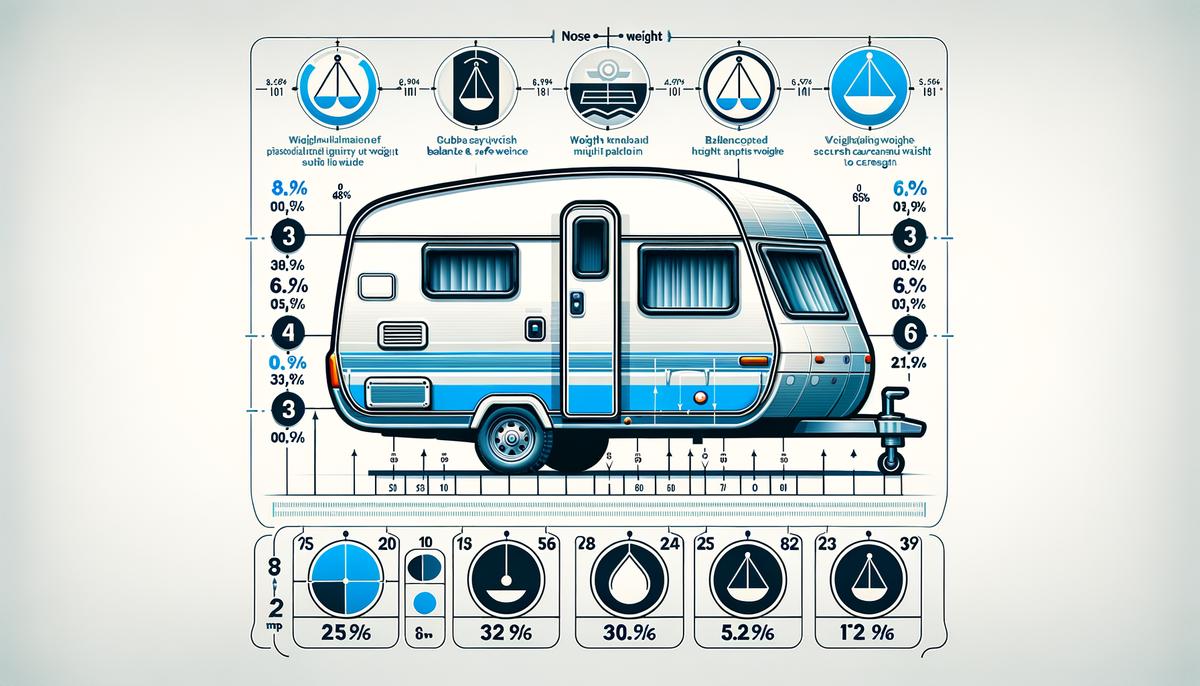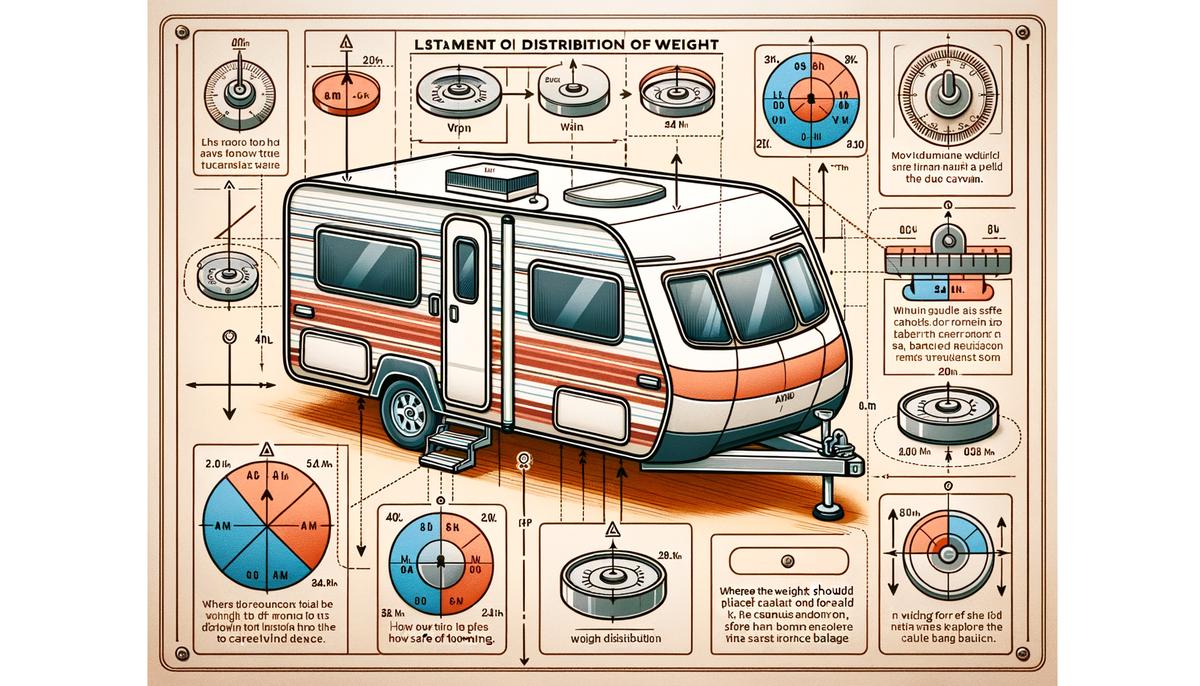Towing a caravan can be a bit like a balancing act, where getting the weight just right makes all the difference. Nose weight plays a crucial role in this, as it’s the weight pressing down on the tow ball of your car. It’s a bit like making sure your luggage isn’t too heavy for a plane’s takeoff. Understanding how to measure your caravan’s nose weight correctly and knowing how to distribute weight inside it couldn’t be more important. It ensures that your journey is not only smooth but safe too. Whether it’s placing your camping gear just right or knowing how much weight to put in the boot of your car, every little adjustment can help make your trip a breezy adventure.
Understanding Nose Weight and Its Importance
Nose weight refers to the downward pressure that the loaded caravan exerts on the hitch point of the towing vehicle. This is a critical factor in towing safety, as it directly influences the stability of both the caravan and the towing vehicle. The correct nose weight helps ensure that the caravan remains steady behind the vehicle, reducing the risk of swaying or jack-knifing, especially at higher speeds or in challenging driving conditions. It is usually measured in kilograms and varies depending on the type and model of both the caravan and the vehicle.
To maintain optimal performance and safety, it is essential to adhere to the recommended nose weight specified by the vehicle’s manufacturer. This can typically be found in the vehicle’s handbook. Having too much nose weight can cause the rear of the towing vehicle to sag, affecting the vehicle’s handling and potentially its braking efficiency. On the other hand, too little nose weight can make the caravan more prone to swaying, which can be dangerous. Achieving the correct nose weight is a balance; it involves distributing the load within the caravan appropriately, ensuring that heavier items are placed near the axle and as low as possible. This balance is crucial for safe and comfortable towing, providing peace of mind during travel.

How to Accurately Measure Your Caravan’s Nose Weight
Measuring the nose weight of your caravan accurately is pivotal for towing safety and balance, and thankfully, it’s not a complex task. One can use a specific tool known as a nose weight gauge, which is readily available at most caravan accessory stores. The process involves placing the gauge directly under the tow hitch of the caravan, then lowering the jockey wheel until the full weight of the caravan’s nose rests upon the gauge. The reading should then give you a clear indication of your caravan’s current nose weight. It’s crucial to carry out this measurement when your caravan is fully loaded as you would have it when setting off on a trip, ensuring that all items are packed in their designated places to reflect an accurate real-world scenario.
However, if one doesn’t have a nose weight gauge at hand, visiting a public weighbridge can also provide an accurate measurement, albeit with a bit more effort. Upon arrival, you’ll need to place only the caravan’s tow hitch on the weighbridge while keeping the weighing platform clear of the towing vehicle and the rest of the caravan. This method allows you to get a precise measure of the nose weight exerted on the tow ball. Regardless of the method chosen, it’s essential to check this weight against the manufacturer’s recommended limits to ensure you’re within the safe operating range. Regularly monitoring and adjusting the nose weight of your caravan before each journey can mitigate the risk of accidents and contribute to safer towing practices.
In essence, taking the time to accurately measure and adjust the caravan’s nose weight is not just a regulatory compliance matter but a cornerstone of safe caravan towing. This step, although might seem minor in the grand scheme of preparations, plays an outsized role in maintaining the balance and stability of your caravan, ensuring a smoother, safer journey.
Optimal Distribution of Weight Within the Caravan
Ensuring optimal distribution of weight inside your caravan not only influences the nose weight but is paramount for maintaining balance and ensuring safety while towing. Heavier items should be strategically placed over the axle and as close to the floor as possible. This arrangement aids in lowering the caravan’s centre of gravity, significantly enhancing stability and reducing the risk of swaying during transit. Lightweight items, conversely, can be stored in higher or peripheral compartments, taking care to avoid placing too much weight towards the front or rear of the caravan, which could lead to undue pressure on the tow ball or affect the towing vehicle’s traction by lifting its rear.
To optimise the nose weight and achieve the safest towing experience, it’s crucial to pack the caravan judiciously. Start by identifying items based on their weight and necessity for the trip. It’s essential to evenly distribute medium-weight items around the caravan’s axle, never exceeding window level. Such meticulous packing ensures that the downward force on the tow ball remains within the recommended limit, reflecting a commitment to safety and comfort. By adhering to these guidelines, caravaners can enjoy a smoother ride, with the reassurance that their vehicle is optimally loaded for the journey ahead, steering clear of common pitfalls associated with improper weight distribution.
Adjusting Nose Weight Through External Load Adjustments
To fine-tune your caravan’s nose weight for optimal towing performance, external adjustments can often make a significant difference. One effective method is adjusting the tow hitch height on your towing vehicle. By either raising or lowering the tow hitch, you can alter the angle and distribution of weight throughout the caravan. This process requires a compatible tow hitch that allows for height adjustment, ensuring that the caravan remains as level as possible with the towing vehicle. Achieving a level stance minimizes the stress on both the caravan and vehicle, contributing to a more stable and safer towing experience.
Another external adjustment involves the use of stabilisers or weight distribution systems. These systems can be attached to the caravan’s chassis and the tow vehicle’s hitch assembly. They work by spreading the load more evenly across both the caravan and the vehicle, thereby optimizing the distribution of nose weight. It’s crucial, however, to select a system that’s compatible with your specific caravan and towing vehicle model to ensure efficacy. Proper installation and adjustment of these systems can dramatically improve the towing dynamics by reducing sway and enhancing the overall stability of the caravan. By meticulously applying such external adjustments, caravanners can ensure a safer, more enjoyable journey without compromising on performance or safety.

So, keeping an eye on the nose weight and how you pack your caravan is key to a smooth journey. Like finding the perfect ingredients for a cake, getting this balance right ensures that your caravan trip is as sweet as it can be. Remember, making sure that your caravan is correctly packed isn’t just about avoiding a wobbly ride; it’s about making memories on the road safely. So, take a little time to weigh, arrange, and adjust. This way, you can focus on the adventures ahead, knowing your caravan is set up for a safe and joyous journey.
Get top-notch AI content with Writio – Your go-to for quality written articles. This page was crafted by Writio.
Leave a Reply